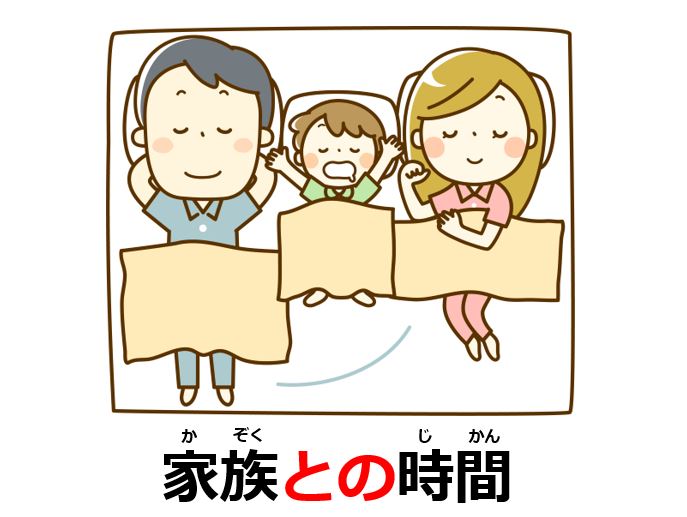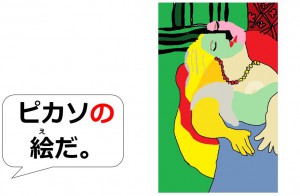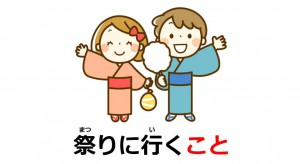Last time, you learned what functions the particle の has, which are Possessor, Author (Creator), Explanation, Position, and Apposition. Since each particle has various functions, your expression will be more colorful if you can use them together. In this lesson, you will learn how to use combined particles.
Explanation for Combined Particle by Using Focus Particle and Noun Phrase
| Table of Contents Focus Particle は and も Noun + Particle + Partilce の + Noun Noun Phrase with the Particle から and まで (Advanced) Focus Particle は and も with Verbs and Adjectives |
First of all, the patterns of combination are already defined. You will learn just two patterns here. By following the rule, you can make a natural sentence.
Focus Particle は and も
For the sake of explanation, let us call は and も a “Focus Particle.” This is because は and も have a special function (You will see it in the advanced topic). The first pattern is to attach は or も to other particles. Let’s check some examples.
| [私は / が] | お母さんには | 手紙を | 書く / 書きます |
| [Topic / Subject] | Target & Contrast | Direct Object | Verb |
| [I will] write a letter to my mother. *Implies that he/she won’t write a letter to other people. |
|||
| [私は / が] | お母さんにも | 手紙を | 書く / 書きます |
| [Topic / Subject] | Target & Inclusion | Direct Object | Verb |
| [I will] write a letter to my mother, too. *Implies that he/she will write a letter to other people, too. |
|||
That’s easy, isn’t? Please focus on the functions that each particle has. Here are more examples.
| [私は / が] | 学校には | 行く / 行きます |
| [Topic / Subject] | Destination & Contrast | Verb |
| [I will] go to school. *Implies that he/she won’t to go other places. |
||
| [私は / が] | 学校にも | 行く / 行きます |
| [Topic / Subject] | Destination & Inclusion | Verb |
| [I will] go to school, too. *Implies that he/she will go other places, too. |
||
| [私は / が] | ケンとは | 握手する / します |
| [Topic / Subject] | Partner & Contrast | Verb |
| [I will] shake hands with Ken. *Implies that he/she won’t shake hands with other people. |
||
| [私は / が] | ケンとも | 握手する / します |
| [Topic / Subject] | Partner & Inclusion | Verb |
| [I will] shake hands with Ken, too. *Implies that he/she will shake hands with other people, too. |
||
| [私は / が] | プールでは | 泳ぐ / 泳ぎます |
| [Topic / Subject] | Location of Action & Contrast | Verb |
| [I will] swim in the pool. *Implies that he/she won’t swim in other place. |
||
| [私は / が] | プールでも | 泳ぐ / 泳ぎます |
| [Topic / Subject] | Location of Action & Inclusion | Verb |
| [I will] swim in the pool, too. *Implies that he/she will swim in other place, too. |
||
Note: You CANNOT combine は and も with the particle が and を. If you’d like to express contrast or inclusion in が and を parts, you have to replace them.
| リンゴ => Wrong! |
| リンゴもおいしい(です)。 Apples are also delicious. |
| リンゴ => Wrong! |
| リンゴも食べる / 食べます。 [I will] eat apples, too. |
[adsense]
Noun + Particle + Particle の + Noun
The basic function of the particle の is to make a noun phrase by connecting two nouns like 日本語の先生. You can consider 日本語の先生 as a single noun. In practice, other particles sometimes appear before の, which forms the sentence pattern: Noun + Particle + Particle の + Noun. This is another pattern of combined particles.
Reword a Sentence with a Noun Phrase
| 図書館で勉強(する / します)。 [I will] study in the library. |
| 図書館での勉強 Studying in the library |
The above examples essentially have the same meaning. If you use only the particle の, the phrase “図書館の勉強” would mean “studying about libraries.” By placing the particle で, which indicates locations of action, you can reword the sentence.
| 図書館での | 勉強は | 効果的(だ / です) |
| Location of Action & Explanation |
Modified Noun | |
| Noun Phrase: Topic / Subject | Predicate | |
| Studying in the library is effective. | ||
This expression can be utilized like the above. The role of the noun phrase is determined by the particle placed after that, which is は in this example. Here are more examples.
| 大阪へ旅行(する / します)。 [I will] travel to Osaka. |
| 大阪への旅行 Travel to Osaka |
| 彼女と結婚(する / します)。 [I will] get marry to my girlfriend. |
| 彼女との結婚 Marriage to my girlfriend |
| お母さんから手紙を(もらう / もらいます)。 [I will] receive a letter from my mother. |
| お母さんからの手紙 Letter from my mother |
| 5時まで仕事を(する / します)。 [I will] work until 5 o’clock. |
| 5時までの仕事 Working until 5 o’clock |
Note: You CANNOT combine the particle の with the particle に, は, も, が and を. Regarding the particle に, if it indicates “destination” or “direction,” you can express the same meaning by using the particle へ like the second example.
Noun Phrase with the Particle から and まで
These are actually not combined particles. から and まで can form noun phrases with other particles and so it resembles combined particles. That’s why we will pick this up here.
| 冬は | 12月から | 3月までが | 寒い(です) |
| Starting Point | Ending Point | ||
| Topic | Noun Phrase: Subject | Predicate | |
| As for winter, it’s cold from Dec to Mar. | |||
You can consider 12月から3月まで as a single noun. The role is determined by the particle placed after that, which is が in this example. Since this is just a noun, から and まで can be used with even が and を unlike combined particles. Here are more examples.
| 日本語は | 5ページから | 9ページまでを | 勉強する / します |
| Starting Point | Ending Point | ||
| Topic | Noun Phrase: Direct Object | Verb | |
| As for Japanese, [I will] study from 5 page to 9 page. | |||
| 宿題は | 5時から | 10時までで | する / します |
| Starting Point | Ending Point | ||
| Topic | Noun Phrase: Range (Period of Time) | Verb | |
| As for the homework, [I will] do [it] from 5 o’clock to 10 o’clock. | |||
That’s simple, isn’t it? One thing you should pay attention to is that particles placed after noun phrases are sometimes omitted. In that case, you need to guess the roles of noun phrases based on the context. The following are also correct.
| 冬は12月から3月までが寒い(です)。 |
| 日本語は5ページから9ページまでを 勉強(する / します)。 |
| 宿題は5時から10時までで (する / します)。 |
(Advanced) Focus Particle は and も with Verbs and Adjectives
The focus particle は and も can be placed after verbs, adjectives, and nouns. Although you can spice up your expression more, you need to conjugate them properly. Let’s go over the rules.
U-verbs: Stem + i + Focus Particle + する
書く: to write
| Casual | Polite | |
| Stem | kak | |
| Plain Form | 書きはする kakihasuru |
書きはします kakihashimasu |
| Negative Form | 書きはしない kakihashinai |
書きはしません kakihashimasen |
Ru-verbs: Stem + Focus Particle + する
見る: to see, look, watch
| Casual | Polite | |
| Stem | mi | |
| Plain Form | 見はする mihasuru |
見はします mihashimasu |
| Negative Form | 見はしない mihashinai |
見はしません mihashimasen |
Two Exceptions
来る: to come
| Casual | Polite | |
| Stem | ku/ko/ki | |
| Plain Form | 来はする kihasuru |
来はします kihashimasu |
| Negative Form | 来はしない kihashinai |
来はしません kihashimasen |
する: to do
| Casual | Polite | |
| Stem | su/shi | |
| Plain Form | しはする shihasuru |
しはします shihashimasu |
| Negative Form | しはしない shihashinai |
しはしません shihashimasen |
Na-adjective and Nouns: Adding で + Focus Particle + ある/ない
きれい: beautiful
| Casual | Polite | |
| Plain Form | きれいではある | きれいではあります |
| Negative Form | きれいではない | きれいではありません |
I-adjective: Replacing い with く, and Adding Focus Particle + ある/ない
寒い: cold
| Casual | Polite | |
| Plain Form | 寒くはある | 寒くはあります |
| Negative Form | 寒くはない | 寒くはありません |
Examples
The concept is the same as the combined particles. By looking at the function of the focus particles, you can figure out the meaning of whole sentences. This time, we will make examples with も.
| 田中さんは | 本を | 読みも(しない / しません) |
| Topic / Subject | Direct Object | Verb + Inclusion |
| Tanaka-san won’t even read the book. | ||
The particle も expresses inclusion. With the example above, it implies that Tanaka-san won’t read or do any other activities. Thus, it can roughly be translated as “even” and implies surprise or unexpectedness.
| 私は | 学生でも(ある / あります) |
| Topic / Subject | State-of-Being + Inclusion |
| I’m even a student. *Implies that he/she is something else, too. |
|
| 納豆は | おいしくも(ない / ありません) |
| Topic / Subject | Predicate + Inclusion |
| Natto (Japanese cuisine) is not even delicious. *Implies that Natto also smells bad or something. |
|
Note: this usage, especially for when you modify adjectives and nouns in affirmative sentences, will sound a little formal. Thus, you may not often hear this in conversation, while the negative form sounds neutral.
Summary
- You can attach は or も with other particles as a combined particle except for が and を.
- You can form noun phrases by combining の with other particles except for に, は, も, が, and を.
- You can form noun phrases by combining から or まで with other particles (including が and を).
- Focus particle は and を can modify verbs, adjectives, and nouns.
We hope that you don’t have any difficulty in this lesson. Japanese can be easily figured out if you know the usages of the Japanese particles. Thus, if you had tough time, you may review what you have learned so far. Next, you will learn something related to noun phrases. You can even use verbs and adjectives as a noun like “doing,” “to do,” and “being….”





